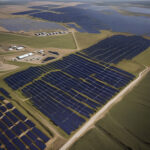The rapid advancement of artificial intelligence (AI) technologies has sparked an unprecedented surge in the need for data processing capabilities. Consequently, AI data centres have proliferated across the United States, drawing attention to their monumental power consumption, which poses significant challenges for the nation’s electrical grid. This article explores the intricate dynamics of AI data centres, their energy demands, and the broader implications for the US power infrastructure.
The Power Drain of AI Data Centres
AI data centres are designed to handle vast amounts of data through high-performance computing (HPC) systems. These facilities require a significant amount of energy to operate—not just for powering the computing hardware, but also for cooling systems necessary to mitigate the heat generated from continuous operations. Reports indicate that AI data centres consume up to three times more power than traditional data centres due to their advanced computing capabilities and intensive workload requirements.
For example, a typical AI training session, which may involve processing countless datasets, can consume around 20 megawatt-hours (MWh) of electricity. To put this into perspective, this amount is roughly equivalent to the yearly energy consumption of an average American household. As AI technologies advance, the power requirements are only expected to grow, highlighting a pivotal challenge for energy sustainability.
Grid Stability Threats
This rapid increase in power usage raises concerns about grid reliability. Analysts have identified a correlation between the uptick in data centre activity and disturbances in power quality, such as “bad harmonics.” Harmonics can lead to inefficiencies in electrical systems and ultimately threaten the stability of the power grid, making the infrastructure vulnerable to outages.
Moreover, the significant energy draw from AI data centres may strain local grids, especially during peak usage periods when electricity demand surges. As AI capabilities expand, so too does the necessity for robust energy management strategies aimed at integrating these new power demands into existing grid frameworks.
National Energy Security Considerations
The energy consumption by data centres also poses strategic concerns for national energy security. The more reliant the country becomes on electricity-intensive technologies, the higher the risk for energy shortages and supply instability. In scenarios where grid demand exceeds supply, energy prices may surge, further complicating the operational costs for companies running data centres.
To counter these risks, it’s essential to promote energy-efficient technologies and practices within AI data centres. Implementing strategies such as advanced cooling techniques, energy management systems, and even investing in renewable energy sources could significantly mitigate some of the strain these data centres impose on the grid.
The Shift Towards Sustainable Practices
Innovations in renewable energy technologies present a tremendous opportunity for data centres to reduce their carbon footprint and reliance on traditional power sources. Companies are increasingly adopting greener practices, such as purchasing renewable energy credits (RECs) or entering power purchase agreements (PPAs) with solar, wind, or hydro power providers. These initiatives not only support sustainability efforts but also stabilize energy costs over the long term.
Take, for instance, Google’s data centres, which have achieved net-zero energy consumption through extensive investments in renewable energy. Google reports that they match 100% of their energy consumption with renewable sources, showcasing that tech giants can lead the way toward a sustainable energy future.
A Collaborative Approach
Addressing the energy challenges posed by AI data centres is not solely a responsibility of individual organizations; it requires a cooperative effort among policymakers, energy providers, and technology companies. Regulators must create frameworks that encourage energy efficiency and support innovations in smart grid technologies. Additionally, public-private partnerships could lead to the development of more efficient transmission systems that better manage and distribute energy where it’s most needed.
Furthermore, fostering research into energy storage solutions, such as large batteries or other technology, can help balance supply and demand, providing vital support during peak times while enabling data centres to run sustainably.
Conclusion
The intersection of AI advancements and energy consumption represents a complex challenge for the United States power grid. As AI data centres expand, the implications for energy security, grid reliability, and sustainability are considerable. Stakeholders must work collaboratively to adopt innovative solutions that enable the tech industry to thrive without compromising the stability of the nation’s power infrastructure.
Balancing technological growth with responsible energy usage will not only ensure the resilience of the power grid but also pave the way for a more sustainable digital future.












